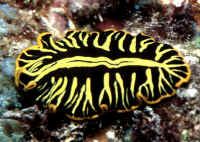

While the first foraging trails to appear in the fossil record were rather inefficient and often criss-crossed each other (which is why they are often called "scribbles"), more regular, "meandering trails" had appeared by the end of the Precambrian, which looped back on themselves without crossing (Prescott, 2001, p. 12). For Prescott, these trails point to the emergence of the first creatures with brains.
Prescott invokes Occam's razor to argue that the fossil trails should be explained in the simplest possible way. He cites research by Raup and Seilacher (1969, cited in Prescott, 2001, pp. 12 - 13) that describes how computer simulations of the meandering trace fossil tracks can be generated by combining four simple behaviour mechanisms: stay close to previously formed tracks (thigmotaxis), avoid crossing existing tracks (phobotaxis), advance when the preceding conditions are not met; and make 180 degree U-turns at various intervals (strophotaxis), which is achieved by swapping control from one side of the body to the other at various intervals. While the first two behaviour patterns are reflexive mechanisms associated with an animal's peripheral sensors, and the third mechanism (advance) is merely a default, the behavioural component that suppresses signals from one side of the body while the other is active, functions as a centralised conflict-preventing mechanism, of vital importance to an organism with a brain and bilateral symmetry. Prescott considers this a breakthrough in the evolution of "action selection". Citing the work of researchers Koopowitz and Keenan (1982), he proposes that
Animals of this sort are known to have been present in the [late] Precambrian [565 to 544 million years ago - V.T.], as demonstrated by the large number of trace fossils that have preserved the behaviour (e.g. foraging trails) though not the body forms of worm-like animals from that period. Simulation of these trace fossil patterns indicates a capacity for intelligent co-ordinated behaviors not unlike that demonstrated in some simple behavior-based robots (2001, p. 3).
the flatworm brain is primarily a mechanism that prevents the two sides of the body "from engaging in contradictory activities"... [T]he appearance of efficient foraging trails in the fossil records of the Precambrian may mark the point where centralized action selection mechanisms [i.e. brains - V.T.] had evolved to take control over peripheral reflex systems (2001, p. 15).